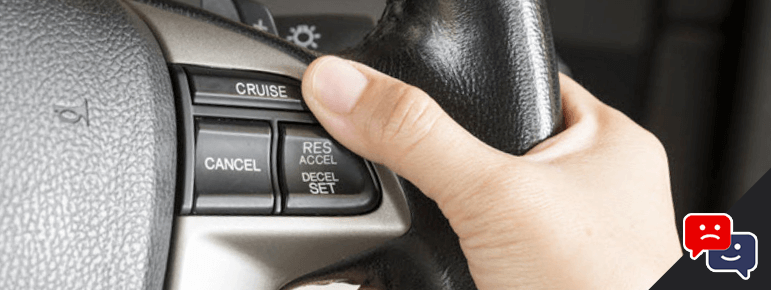Last Updated on April 4, 2024
Fuel economy is an important part of a car’s function, and car owners are always on the lookout for ways to improve their MPG. But what does cruise control do, and can it really save you money on gas?
Yes, cruise control can save roughly 7-14% on gas, making it a more fuel-efficient way to drive. Because a steady consistent speed is less demanding on the engine than sudden acceleration or deceleration. The result is less fuel consumed per mile.
If you’re like most car owners, you find yourself asking a lot of questions about how to save money on gas.
And you may have heard of cruise control being touted as an instant fix. But, does it actually make a difference?
Yes actually, and as it turns out, cruise control is a great feature for saving money on gas. Especially if you’re expecting a long drive ahead.
In this guide, we’ll explore how this feature works and why it’s a mileage booster. Then, we’ll provide tips for when you should use it.
So, if saving some money at the pump is important to you – read on!
What is Cruise Control?
Simply put, cruise control is an electronic system allowing a driver to set the desired traveling speed.
Once set, the driver does not need to keep a foot on the gas pedal to maintain forward motion. Instead, the cars cruise control automatically holds the vehicle to a set speed.
This is particularly helpful when driving long distances, especially on long freeways.
Why Does Cruise Control Save Gas?
The main reason cruise control saves you money on gas is one of consistency. Cruise control maintains a constant speed without need for constant pressure on the accelerator.
As such, your car isn’t slightly accelerating or decelerating as it would be in normal driving conditions.
These differences may seem trite, but over a period of time, acceleration and deceleration can eat up more gas as compared to traveling as a steady constant speed.
In fact, the Natural Resources Canada conducted a study on the effects of using cruise control compared to not using it.
What they found was eye opening. Vehicles traveling with a fluctuating speed between 47 and 53 mph used 20% more gas on average when compared to a vehicle using cruise control.
Truth is, cruise control allows you to effortlessly place your car on autopilot and keep a steady speed.
When to Use Cruise Control
It’s best to use cruise control when driving on long empty roads, such as a highway or an interstate. Long, flat country roads that are free from traffic congestion are also ideal for cruise control.
When Not to Use Cruise Control
Cruise control is only effective in specific circumstances. For example, on rougher terrain, cruise control actually yields a worse MPG than driving the car normally.
In addition, cruise control shouldn’t be used during inclement weather conditions. Because cruise control reduces the amount of autonomy you have over your car.
So it’s not suited for driving in thunderstorms, snowy conditions, or on icy roads.
Moreover, you can’t use cruise control when traffic isn’t moving at a consistent pace for obvious reasons.
Can You Hit The Gas While on Cruise Control?
Hitting the gas pedal will turn off the cruise control. However, most modern cars will have additional buttons on the steering wheel to allow the driver to adjust speed, or briefly pause cruise control.
Is Adaptive Cruise Control the Same As Traditional Cruise Control?
Cruise Control has been a staple of automobiles for decades, but its latest iteration – Adaptive Cruise Control (ACC) – takes road safety to the next level.
Adaptive cruise control was invented in 1990 by William Chundrlik and Pamela Labuhn. General Motors would then patent the design in 1991.
ACC not only keeps you driving at your desired speed like traditional cruise control does, it also adjusts that speed depending on surrounding traffic.
With this added safety feature – drivers can rest assured their vehicles will maintain an appropriate distance from other cars and brake when necessary to avoid collisions.
Adaptive Cruise Control uses radar or cameras to detect the speed and distance of the vehicle in front of you. If the vehicle in front of you suddenly slows down – ACC will slow automatically slow down your vehicle as well.
When the road ahead clears, Adaptive Cruise Control automatically returns to your pre-set speed.
Simply put, traditional Cruise Control is a system that helps you maintain a constant speed. By contrast, Adaptive Cruise Control has the ability to allow the cars computer to adjust speed based on the traffic patterns around you.
Final Thoughts: Does Cruise Control Save Gas
Cruise control does help to save money on gas, especially on long stretches of road where consistent speed matters.
It does so by leveling out the speed of your vehicle. This allows the transmission and engine to work at their most efficient state over a long period of time. The result – improved fuel economy.
Of course, cruise control isn’t usable in every situation, but it’s definitely a great feature to use during a long drive if you have the option.

Managing Editor
Christopher is an automotive technical writer. When he’s not at the local autocross event, he can often be found working on one of his cars. Specializes in automotive class action law, industry trends, and automotive maintenance. Email me direct, or learn more about us

